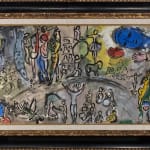Marc Chagall Russian, 1887-1985
42 x 78.5 cm
On their visits to Vitebsk, Russia, the travelling acrobats and equestrians who came to entertain the townspeople fascinated the young Marc Chagall, and the circus would form an enduring part of his iconography as an artist. He felt a particular kinship with these performers, linking them to his own creative life and the path chosen for himself. One early memory of a father-son duo performing a strenuous acrobatic act that gained more scorn than praise from its audience left an indelible impression on Chagall, signaling the perils of an artistic life dependent on others.
In 1927, the famed dealer Ambroise Vollard asked Chagall to produce a series of prints on the circus and the pair regularly visited the entertainments in Paris. The prints contain an unconcealed joy and exuberance in their brightly colored, energetic compositions. Almost exactly thirty years later, in 1956, Chagall would begin work on a large oil and gouache on canvas entitled Le cirque, perhaps inspired by the months he spent in Vence that year, after receiving an invitation to attend the recording of a circus film.
In this study, completed in the same year as his ambitious canvas, Chagall’s whimsy and ‘childish delight’ in depicting le cirque are evident. It bears the same color palette of blues, yellows, and reds and shows an exploration of possible figures to populate his painting: a bird, a horse, a man on stilts edging into frame at the right, an acrobat who’s seemingly mislaid his head.
The numerous figures in a circus—acrobats, ballerinas, musicians—and animals were a source of tragic humanity to Chagall, akin to religious figures or Cervantes’ Don Quixote:
“I have always considered the clowns, acrobats, and actors as being tragically human who, for me, would resemble characters from certain religious paintings. And even today, when I paint a Crucifixion or another religious painting, I experience again almost the same sensations that I felt while painting circus people, and yet there is nothing literary in these paintings, and it is very difficult to explain why I find a psycho-plastic resemblance between the two kinds of composition.”
Le Cirque sold at Sotheby’s in 2017 for $16 million, one of the highest prices paid at auction for work by Marc Chagall. He would paint scenes from the circus until his death, near the age of 100, in 1985.
Provenance
Estate of the artist (until 1996)Private Collection, Switzerland (acquired from the above)
Private Collection, Europe (acquired from the above)
Acquire from the above by the previous owner in 2021



